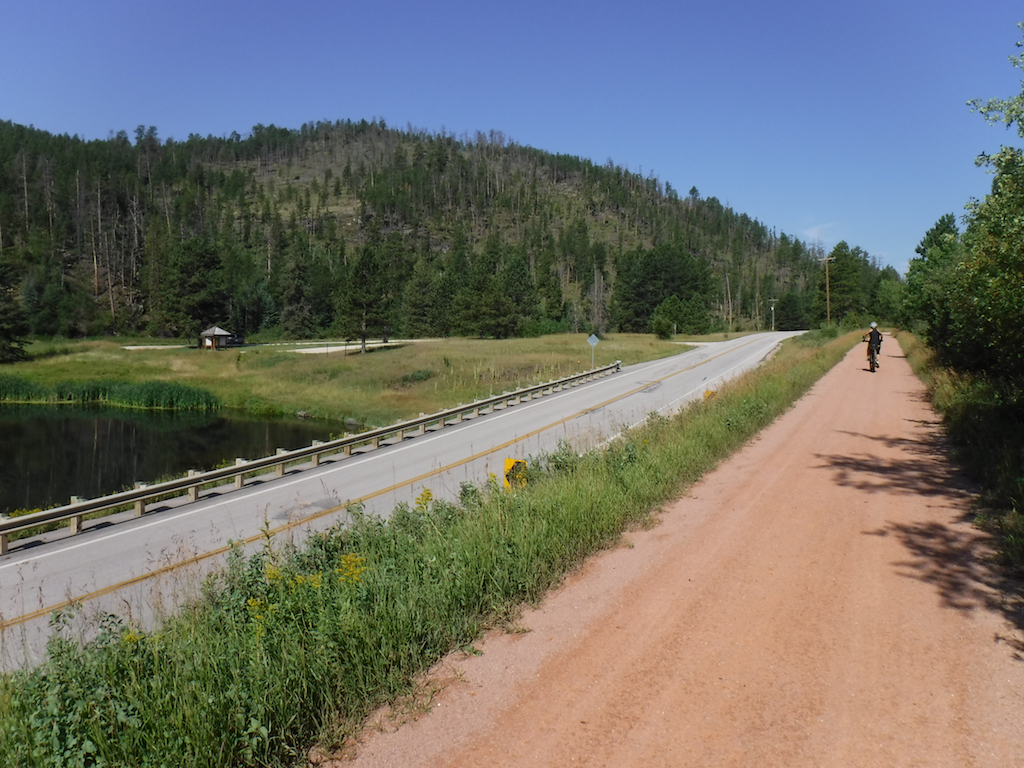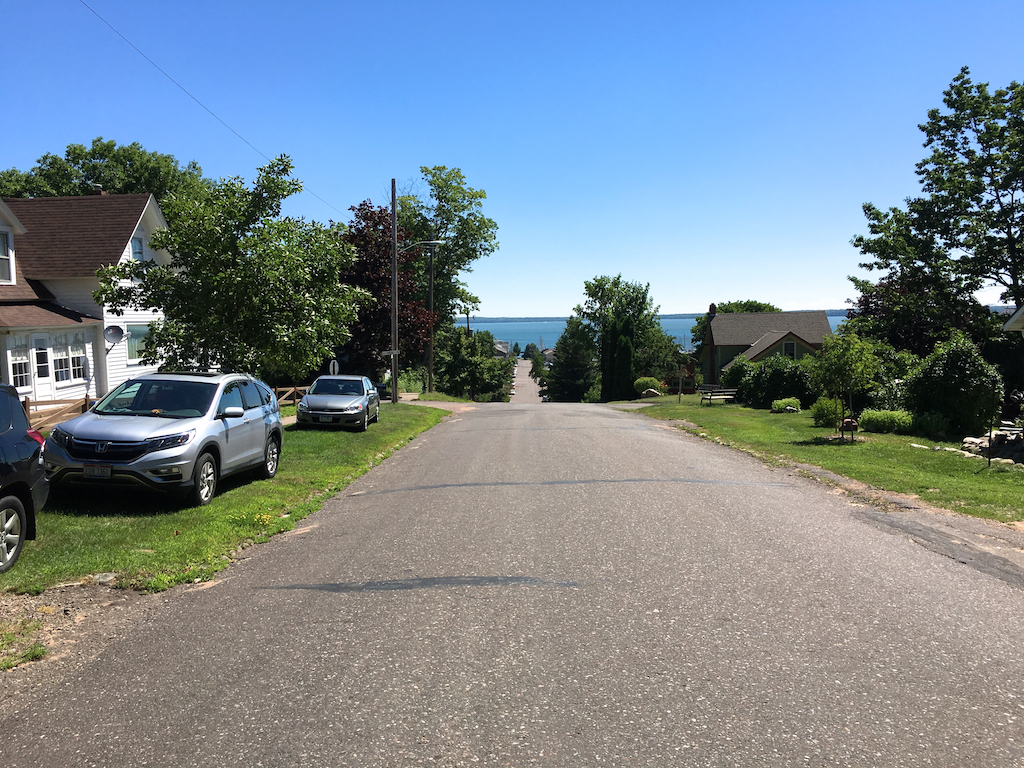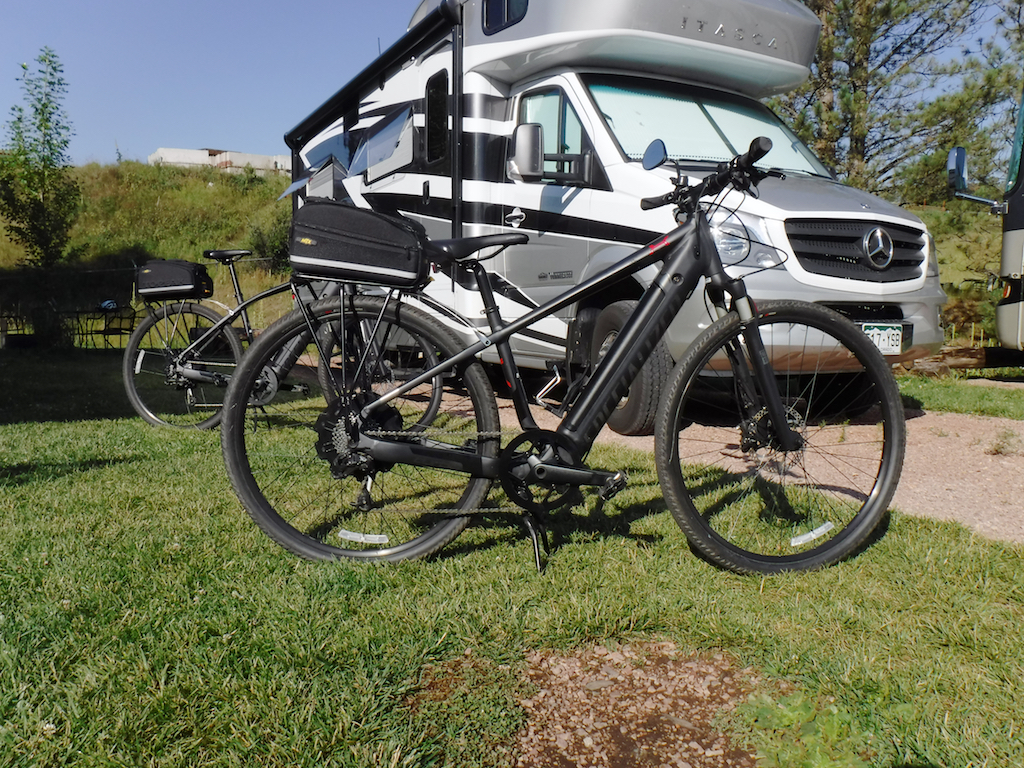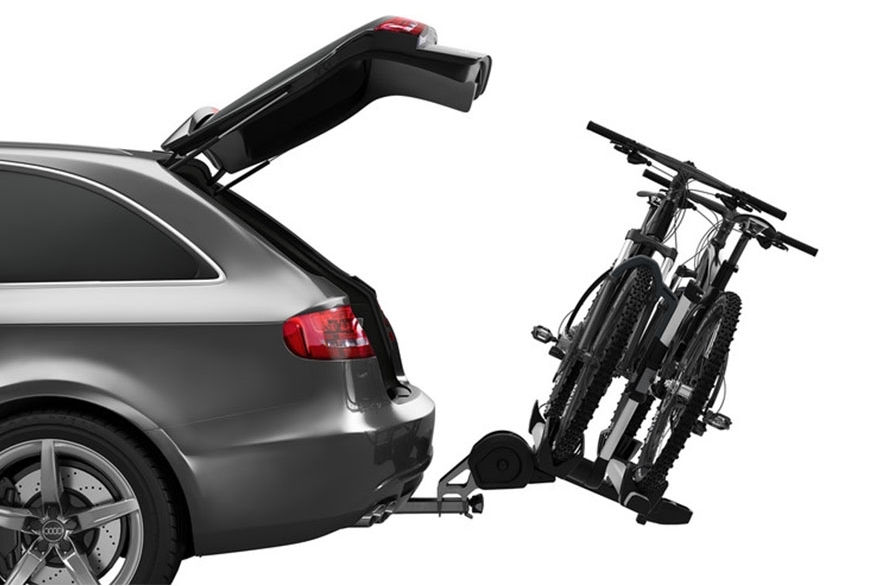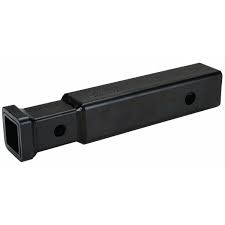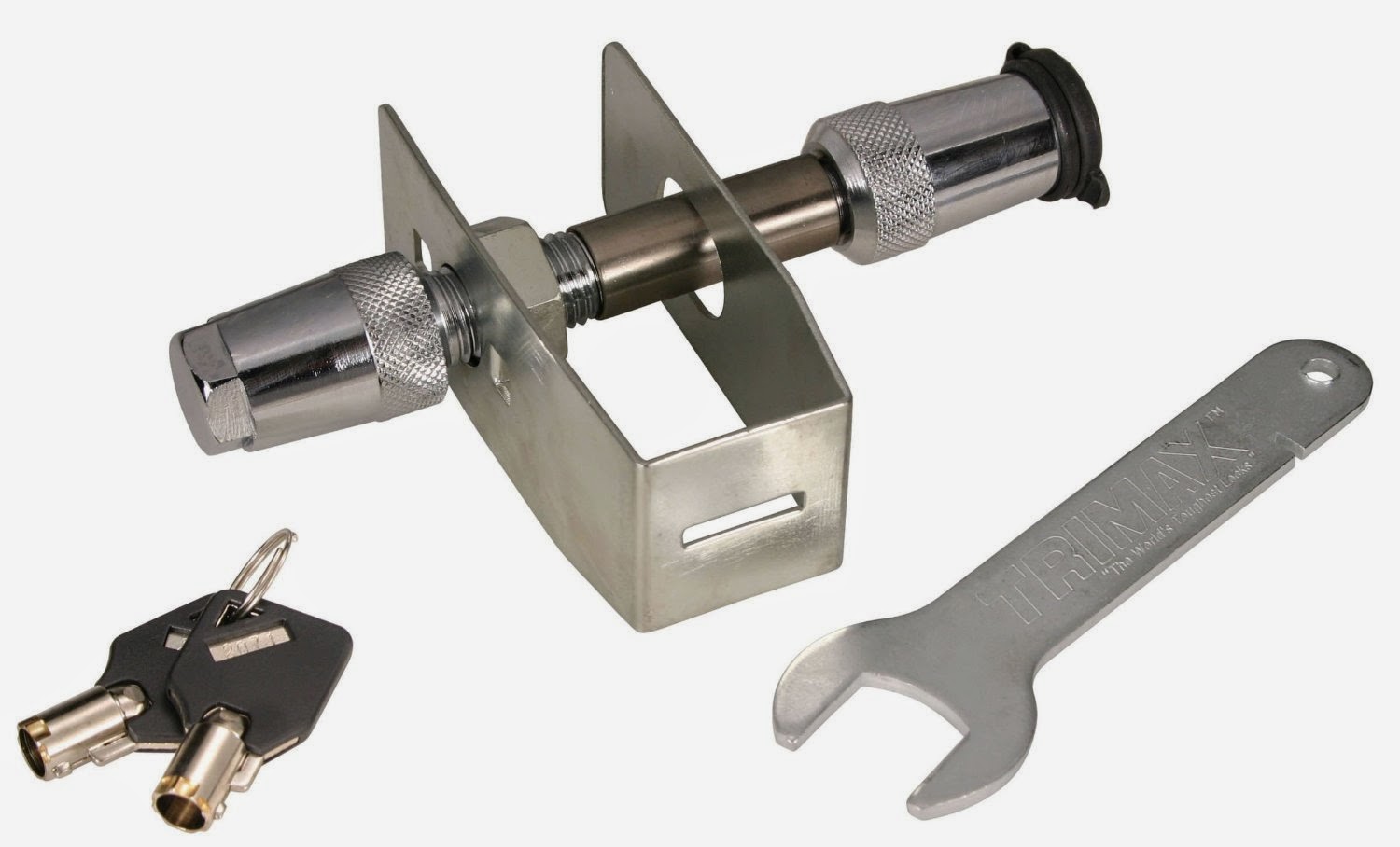
Unexpected Joy on an E-Bike
Unexpected Joy on an E-Bike
An in-depth review and how-to which will enhance both your RV experience and your health
By: Don Cohen
"Try it," my friend Jeff encouraged.
"What do I need to know?" I asked, figuring there was some special protocol.
Jeff pushed a single button and the headlight came on. "Nothing. It's just a bike. Pedal."
Next to the railing on the outside patio of the Union Station Snooze (one of Denver's home grown most popular breakfast spots) leaned Jeff's e-bike. I hopped on and arced around groups of tourists, business people and downtown locals passing in front of the new heart of downtown that, once old, is once again new.
It took me less than a minute to realize that this was to be an expensive breakfast with a trip to the bike dealer later that day. The words game changer are often overused, but as you will soon learn, it's an apt description.
The world of electric high tech has started working its way into cars and now into bikes. Batteries have become more efficient and motors lighter weight and more powerful. Together they're creating a revolution or, at a minimum, rebirth of the joy of biking.
There are two main categories of e-bikes. One is self-propelled where the bike will actually go on its own, like a scooter. The other is a power assist that kicks in only when you pedal. Jeff's bike, and the one just like it that I bought, is a pedal assist. There is no throttle. Just pedal and that's when the magic happens leaving an invisible rainbow trail of shiny electron stars and bubbles behind you.
Not quite as fast as a car, but you cover more miles, more quickly than a regular bike. Here we are on the George S. Mickelson trail in the Black Hills.
I've described the experience to friends in typical boomer cultural reference terms. It's like going from manual to power steering. Or like switching from a manual typewriter to an electric. Putting it in more contemporary terms, you'll win the race without breaking a sweat, but fail the drug test. When you first push down on the pedals you'll feel the bike effortlessly move forward and build speed quickly. In a lot of ways it feels like riding an exercise bike as you continually pedal at a smooth rate yet you'll see the digital speedometer climb to speeds 30%-50% faster than on a regular bike. I now find myself easily sustaining 18-20 MPH speeds -- even on mild uphill stretches.
And hills? I laugh at your hills! On my e-bike it's like you chainsawed the tops of them off. On a regular bike you're looking up the grade already calculating the point where you'll be standing on your pedals, gasping for air, and twisting the handlebars slightly to cross-cut your way to the top. On an e-bike? Drop into an easy gear and keep pedaling. You'll slow down, of course, but you'll stay in your seat and your heart rate will go up into the active exercise mode -- not the call-the-EMTs-with-the-paddles mode.
Not even winded when we climbed up this hill for a view of Bayfield, Wisconsin and Lake Superior, but that was before we got to a more challenging grade minutes later.
An e-bike gives you two things: speed and range. You can go faster which means you can go farther. My wife Terry and I have had our Specialized Turbo-X's for about six weeks and have put over 400 miles on them. We've pushed further out on Denver's extensive bike path system than we ever hadbefore, given them a good workout in Winnebago's hometown of Forest City, ridden up and down the steep hills of Bayfield, Wisconsin and Duluth on the shores of Lake Superior, and cruised along the old railroad grade through the Black Hills.
In Bayfield I found the limits of the turbo assist when I challenged a 12% grade on a residential street. Terry made it to the top on her bike, but even with the power assist, I had to resort to walking the bike for 100 yards. It was then I realized that pushing a 50 pound bike uphill isn't easy. On the spectacular George S. Mickelson bike trail in the Black Hills the bikes simply excelled. In two hours we did a 26 mile out and back route with a couple relentless 4.5% grades. Surprisingly we went uphill at 16-20 MPH and came back down at the same speed. In our bike's "regen" mode we pedaled easily as we went downhill and after two to three miles I saw a 4% INCREASE in battery life.
Our lithium-ion batteries should give us about 40-60 miles of range depending on riding conditions and the weight of the rider, but we've yet to run them dry. After a 35 mile fairly flat urban ride I had 25% battery left. I ride several days a week for exercise and usually go 15-18 miles in an hour or so with 50%+ of battery left. Terry uses less equivalent battery energy on the same rides. This morning, before finishing this post, I went for a 20 mile ride out of downtown Denver into a western suburb. Using my Apple Watch to track my activity I averaged 14 miles per hour, had an average heartbeat of 130 BPM, and expended 1,300 calories. Total time: 80 minutes. I got a solid workout, but never could have literally gone the distance. . .and the speed on a regular bike. This really make aerobic exercise fun.
The Specialized lithium ion battery is beautifully machined and locks onto the bike. There are braze-on screw attachments for mounting a bottle cage. It has four LEDs to tell you battery level at a glance (also displayed in percentage on your handlebar control). Specialized uses a very high quality battery manufacturer who also makes batteries for Apple.
You can charge the batteries on the bike and a full charge can take 4-5 hours. Because we live in a downtown loft our bikes are stored in the garage downstairs. And for us that was a big selling point with the Specialized design which locks the battery to the bike, but is also easy to remove for us to take upstairs for charging. The batteries weigh a hefty 8 pounds, yet when you're on the bike, none of that extra weight seems to make any difference.
Makes, types and prices
After a good degree of research we went with the Specialized Turbo-X.
The only giveaways on our electric Specialized bikes is the fatter tube (with integrated battery) and larger rear hub. On the back are our Topeak racks and packs.
Specialized is an American bike company that is known for high quality mountain bikes. The Turbo-X has many mountain bike features, a sleek battery design that integrates the battery pack instead of looking like a bolted on afterthought. It has a front shock, hydraulic disc brakes, front and rear lights, and digital display. Boy, you'd think I was describing a car!
We briefly considered the Swiss-based Stromer which is more powerful and has additional bells and whistles, but was nearly twice as much as the Specialized. One big consideration for older and less flexible riders is swinging your leg over the top of the bike. If that's a concern, then you should consider a drop step style (it's okay guys, you'll find it easy, too). One e-bike company that offers a nice selection of drop step models is iZip.
For more pleasure bike cruising Pedago offers a variety of styles. We have friends who own them and really enjoy using their Pedagos as city cruising bikes.
Trek is a well known bike manufacturer and we had the chance to ride one recently. The drop step design was easy to mount and it had plenty of zip. It also was much lighter than the Specialized. That's a plus for lifting onto a bike rack. For simple urban cruising these lighter designs would be fine. However, if your biking interests will take to you on rails-to-trails paths, the mountain bike design with wider tires and beefier frames are the way to go.
Electric bikes aren't cheap. . .at least the good ones aren't. You're going to spend as much as buying a nice scooter. With the exception of the Stromers which run between $5,000 - $9,000, most of the other brands will be in the $2,500 to $4,000 range. All in, our Specialized bikes were about $3,000+ each. We bought them from Bike Source in Denver. Like RVs the MSRP is a starting point. With a little on-line research ahead of time you may be able to negotiate a modest discount.
E-bikes and RVing
We always have taken our urban/hybrid regular bikes on the Navion and would often find ourselves pulling the bikes off the rack just a few times on each trip. We never used them that much. Now, it's pretty clear after a recent three week trip, that with the comfort and power of our Turbo-X bikes we're using them more. We generally tow a car behind us which is nice for quick sightseeing and convenience trips from wherever we're camped. However, if you don't have a car, an e-bike can be an excellent option for not only recreation, but for convenience shopping too.
Accessories
Most bikes do not come with bottle cages, and for about $10 bucks they're worth adding. Most bikes have what are called braze-ons which are pre-drilled attachment points for these kinds of accessories. A few years ago we bought into the Topeak rear bike rack system with our previous bikes. We had the Topeak racks installed on our new bikes.
Once mounted to the bike you can buy a variety of packs that slide into the rail and click securely. What's great is that if you've parked and locked the bikes you can easily slide the bag off and carry it on your shoulder. The pack I use has huge expandable saddlebags that zip out which is perfect for a grocery run.
When you are buying your bikes consider negotiating with the bike shop to change out the standard tire tubes with self-sealing ones (around $15 each). Also ask to have liners put in (about $25 for a pair) which adds another layer of protection between the tire and tube to keep those nasty "goat head" stickers from deflating a fun day of riding. If you're planning on trail riding then it's not a bad idea to have a repair kit and one or two extra tubes. An absolute must have are a pair of Pedro's tire levers ($5) these dandy little devices make it much easier getting a tire on and off. I keep a good bike pump in the rig ($50), but carry a much smaller CO2 inflator in the bike bag. I was a few miles away from the RV on the Black Hills bike trail when I discovered a slow leak. Using the CO2 inflator pumped the tire up in seconds and (with a second stop for another re-inflation) it got me back to the rig without having to do an on-the-trail tedious tire repair.
Racks
Over the years I've been very happy with our Thule Vertex ($300) which is great for carrying most styles of bikes. However, our larger and heavier bikes posed a greater challenge using the rack. It worked, but not as well as our ultimate solution of the Thule T2. If there is one downside, the T2 won't work when the Blue Ox tow bar is being used. That means the rack needs to go on the back of your tow car. Of course, if you're not towing, the T2 is fantastic as seen below.
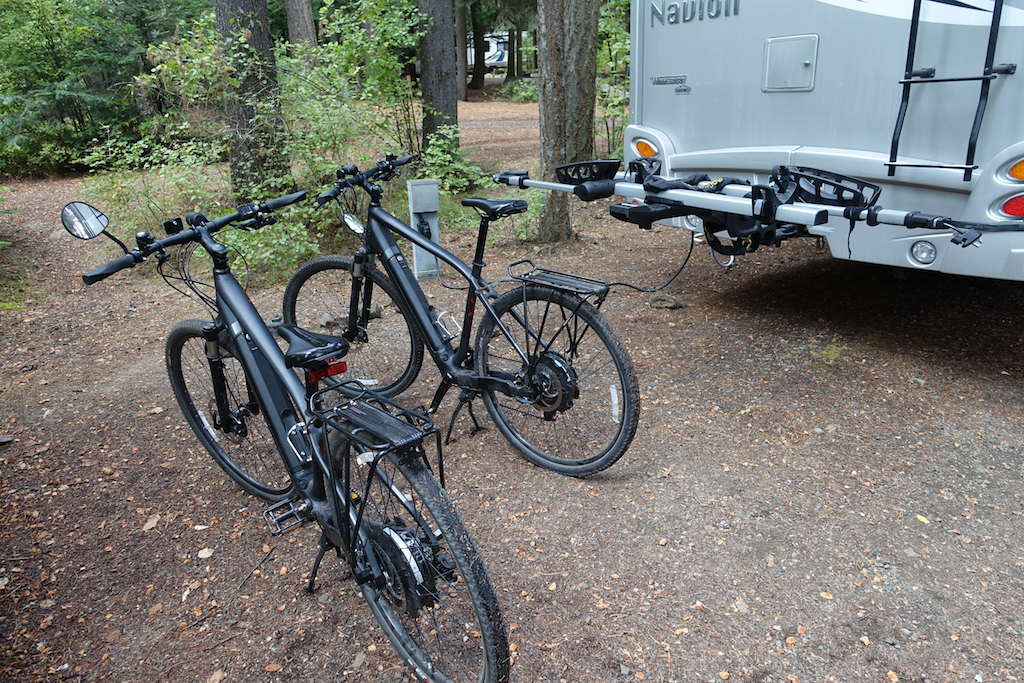
While our "hanging style" Thule Vertex did a fine job on our first 2,000 mile RV trip, there were a couple of things that irritated me. The first was because of the wide style of the bikes and angled drop tubes I couldn't get the bikes close enough to fit a two-bike cover over them. The second was that I scraped a little paint off a few places as the bikes bounced together - though I had separated and bungeed them. I knew a tray style carrier is probably easier to load the bikes onto and can hold them even more securely. One favorite of many of my biking friends is was Thule T2 Pro. But here's the thing: both our cars have 1.25" hitch receivers and the Navion is a beefier 2". While the Vertex rack has an adapter for installing on both sizes, the T2 Pro comes either as a 1.25" or 2" model. What's an e-biker to do?
The Thule T-2 Pro is easy to install, mount, and use.
One strategy was to go back to mounting the bikes on the back of the tow car. Upside #1 is that it would make access to the Blue Ox tow bars a little easier to connect and store. Upside #2 is that it's a lot easier to load a T2 rack. Downside #1 is that if you detached the car for driving around your destination you probably would want to take the bikes off and lock them securely to your rig. Downside #2 is that it tacks on another three feet of length to your mobile wagon train.
So for day-in-day-out use with either of our cars, the answer seemed to be go with the 1.25" model. However, what about those trips where we're not taking a tow car and would like to attach the rack to the 2" receiver of the Navion? This is where it got tricky.
A simple reduction tube from 2" to 1.25" will do the job.
I stopped in at a local hitch company I've used in Denver who carries the Thule T2. In their showroom one of their salesmen actually pulled the rack out and experimented. He took a 2" to 1.25" receiver reducer which he slid into the 2" receiver. He then attached the Thule to the 1.25" end. One super cool feature of the T2 rack is that there's a friction expander you easily tighten with a big knob to firmly lock the rack into the receiver. It's pretty brilliant. But the thing I didn't like was that the adapter was rather loose in the 2" receiver. That would mean a lot of unwanted extra bike jiggling. "Let's try this," Nick the salesman suggested.
This receiver lock also helps tighten the connection. The "U"-shaped bracket fits inside 2" side the reducing tube.
He opened a blister pack with a locking pin system that not only would lock everything together, but also created rock solid connection with the 2" receiver. No wobble! "Ring it up," I declared. I thought I could hear a small whimper coming from the credit card slot in my wallet, but my joy of finally finding a solution drowned out the noise.
The Thule T2 is one of the most expensive racks out there ($560), but you get what you pay for in terms of quality and ease of use.
Security
After writing a big check for your e-bike I can pretty much guarantee you that you're going to be a lot more worried about protecting it. GoLife contributor James Adinaro is a bike expert and rides on some very expensive gear. He's written a great article about bike locks which you can read here.
For security in anchoring our bikes to our rig I went with James' recommendation of the OnGuard Mastiff Chain. It's a beast and you'll be taken aback on its ten pound weight. The only way to cut through the lock or chain is to spend ten+ minutes with a power grinder. This chain, when looped through the bike frames and something like your rear RV ladder will serve as a huge deterrent for opportunistic theft. However, the weight of the chain and lock will discourage you from plopping it in to a bag or pack when biking. For that kind of general locking (like being at a shop or restaurant) a high quality U lock or medium-heavy chain is the way to go.
Communication
If you like riding in pairs then a helmet-to-helmet radio system is a luxury you may not initially consider, but after using, won't want to give it up. The Terrano-X system isn't cheap ($283 at Amazon), but it's very effective. Originally designed by the motorcycle headset company Cardo, Terrano has been spun off to focus on the bike world. It took about twenty minutes to work through the best way to mount the little units on our helmets. The documentation and mounting pieces (velcro and foam pads) were all well thought out.
The Terrano-X system has flexible speakers that sit outside your ears so you can hear everything around you. They're voice activated and Terry and I really have enjoyed using them to check signals and comment about whatever we're seeing on the ride.
Final Thoughts
Test ride before you buy. Buy from a reputable bike store who will stand behind the sale and properly fit the bike for your comfort. Stay away from cheap imported clones (especially because of cut-rate and dangerous lithium ion battery wiring)! You get what you pay for and this is a clear case of investing in quality means having a better ownership experience.
If you're a casual recreational cyclist like me, it's a huge intellectual and financial leap to think about shelling out three grand (or more) for an e-bike. Photographers will tell you that the best camera. . .is the one you'll use. I think this advice is equally true for investing in an e-bike. You want to be very careful that your decision doesn't turn into a Craigslist ad or garage sale item. After using our Specialized Turbo-X bikes for six weeks we have found the unexpected joy of the experience is so satisfying I find myself thinking ahead for opportunities to ride. From Terry's standpoint, bike riding has always been "sort of" fun. But on her Turbo-X it really has become truly fun and she cycles with a lot more confidence and enthusiasm. And I'd say, for both of us, it's a good indicator that there will be a lot of future miles, healthy fun, and pure joy ahead.
*****************************
(Update: 800 miles and counting) Whether traveling or at home, I find myself riding 3-4 times a week with each ride between 12-20 miles on average (60-90 minutes). As my legs have gotten stronger I've decreased the level of boost of the motor to 30-40% which still feels like I'm getting plenty of pedal power. Now, I only kick in the higher Turbo mode for steeper hills or negotiating on city streets. The upside is that with lower battery usage I'm also extending my range. To date the longest single ride I've done has been 34 miles (with 20% battery power left).
After our most recent trip to Idaho, with some incredible rails to trails biking, our thinking has begun to actively seek out RV opportunities that will take us to other great biking destinations. It adds a whole new dimension to our travel planning.
Comments
Comments on this post are moderated, so they will not appear instantly. All relevant questions and helpful notes are welcome! If you have a service inquiry or question related to your RV, please reach out to the customer care team directly using the phone numbers or contact form on this page .
